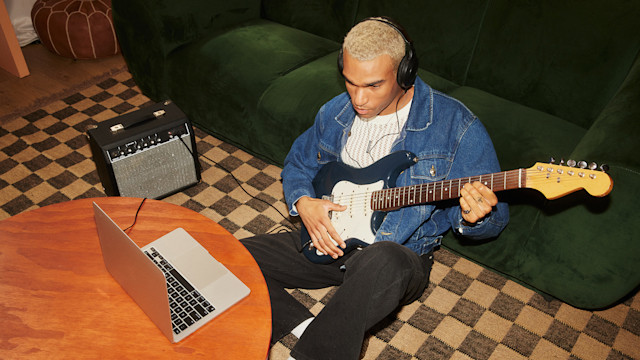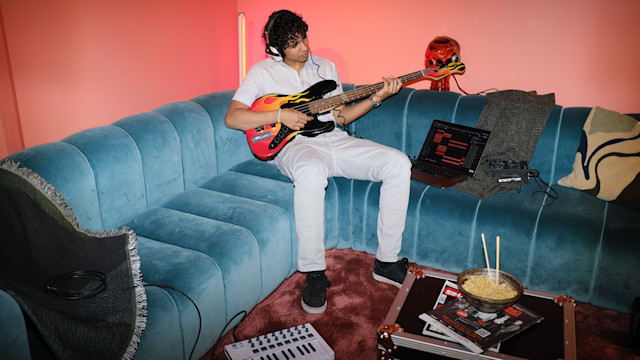How To Set Up A Mobile Recording Studio Anywhere
June 24, 2024 - Learn how to set up a mobile recording studio anywhere with high-quality equipment, transforming any location into a professional studio.

The evolution of home studios has led to a growing interest in setting up a mobile recording studio.
After all, with portable recording studios, you can bring a professional setup with high-quality recording equipment to any location. The advancement of technology over the recent years has enabled us to conduct recording sessions anywhere.
While professional recording environments, of course, remain the preferred work environment for professional sound engineers, there are incredible benefits to setting up a mobile recording studio on the road.
Whether you're a musician, podcaster, or social media content creator, having a mobile recording studio can transform your creative process and give you the freedom to capture inspiration wherever it strikes.
Read more: 7 Steps To Set Up A Music Recording Studio at Home
Setting Up A Mobile Recording Studio
Imagine being able to record, mix, and master your music from anywhere with studio-grade precision. That's exactly what is possible today.
I regularly travel with my mobile production rig for writing sessions, and I'm able to set up a professional studio just about anywhere. In my years of experience, owning a mobile recording studio has paid back big time - I've worked on productions in hotel rooms, basements, hallways, and even on airplanes.
History of Mobile Studios
Origin of Mobile Studios
Mobile recording studios became a reality as soon as laptop technology reached enough power to run Digital Audio Workstations (DAWs) and audio interfaces became small enough to travel with easily. From that moment on, it didn't take a long time for mobile studios to become fairly common.
I owned my first mobile rig around 2005, but the processing power was not enough to run full productions on it. Then, around 2012, I bought my first MacBook Pro, which finally allowed me to run even big DAW sessions on it.
Today, we're on another level when it comes to performance; for most typical production setups, you can easily run your whole studio off a laptop.

Mobile Studio Setup
Setting up a mobile recording studio involves selecting the right equipment and understanding how it fits into the workflow. You'll need reliable recording gear and a thoughtful setup that covers all your needs.
A basic initial equipment setup is fine. You can add to it as you learn more about what works well for you when working away from your studio.
Recording Gear Essentials
The Computer
The laptop is the cornerstone piece of equipment for a mobile recording rig, and truly the mobile part of mobile studio.
Make sure your laptop has enough processing power, memory and storage, or you won't get far. Depending on the amount of storage on your laptop, you might also need to add fast external storage for any large sample-based virtual instruments and additional storage.
Microphone
Second, you'll need a high-quality microphone.
Laptops typically come with a built-in microphone, and they're fine for capturing ideas in a writing session, but once it's time to record for real, you'll need something more professional.
Dynamic microphones are robust and versatile but limited by the frequency range they can capture.
Consider a condenser microphone for capturing more detail; there are many great options, and it really comes down to your budget.
Don't forget essential accessories like shock mounts and pop filters.
Audio Interface
A compact audio interface is vital. Choose a device that offers reliability and portability, with enough inputs to cover your needs on the road. If you're planning on doing a live recording of a band or recording, say, a full drum kit, then make sure your interface has enough inputs and preamps for the number of mics you plan on recording simultaneously.
But if you're recording a single vocal track for a hip hop track, an interface with just one or two inputs will do fine.
Recording live shows introduces some additional needs, like DI boxes and longer cables that allow you to set up somewhere out of the way of the performers.
Monitoring
Unless you're on a hefty budget, have an explicit need for monitor speakers, and don't mind traveling with big, bulky cases, investing in quality headphones is the way to go.
There are countless amazing options for headphones, and again, it mostly comes down to your budget.
MIDI Controller
If you're working on any kind of music, most likely, you'll need a MIDI controller.
A small travel-sized MIDI keyboard will probably cover most of your needs and will be a big help in getting your musical ideas down. Personally, I use a 32-key extra-small keyboard that fits in my laptop bag, and while it's not the most ergonomic instrument to play, it gets the job done.
The DAW
You'll need software to run all your audio gear with.
All modern DAWs are amazing, and your choice comes down to your specific needs and preferred workflow. Soundtrap, Apple Logic Pro, Avid Pro Tools, Steinberg Cubase, Ableton Live and many others are all great options.
If you're looking for an easy way to get started, I recommend you check out Soundtrap. It's a cloud-based DAW that covers all the basic needs and a better way to get you working without the need to install any software.
Alternatives to a DAW
If you're looking to travel light, you could consider using a portable recorder that simplifies the process with built-in mixing and recording features.
A portable mixer can also help you effectively manage multiple audio sources if you use a portable recorder or a more limited audio interface.
Another option for a mobile recording studio is using an audio interface with a tablet like an iPad. This setup supports professional-grade condenser microphones and instruments, giving you a compact, versatile solution.
Soundproofing
Soundproofing accessories, like portable acoustic panels, help create an ideal recording environment even in non-traditional spaces where you don't have access to recording booths. But if you need to travel light, then it's probably not an option to bring anything like this.
One thing I often do when recording a songwriting session in a hotel room or otherwise less ideal space - I use duvets and blankets and hang them directly behind the singer or guitar player. A couple of extra mic stands typically work great for this.
It might not look pretty, but it gets the job done. Capturing a tight, natural, clean sound is one of the most important aspects of music production.
Virtual Instruments
Virtual instruments have evolved to an incredible level, and they certainly make working on the road easier. Instead of carrying around a real piano, you can load up your choice of the latest and greatest sampled piano and record your parts.
Using virtual instruments in creative ways can also help you break all kinds of barriers between musical styles. Experimentation is the name of the game here! If it sounds good, it is good.
Keep in mind that if you're used to a desktop setup with a big monitor, working on your productions on a laptop for the first time is an adjustment.
Also, make sure you have a solid backup process in place; when traveling with your studio gear, there's a greater risk of loss or theft of your equipment. I recommend using a cloud-based backup system that automatically backs up any updated or new files.

The Future of Mobile Studios
Mobile recording studios are evolving rapidly, driven by technological advancements and a growing need for flexibility in music production. I, for one, am excited to see where the technology will take us next.
Advancements and Challenges
For more complex mobile studio setups recording a live performance, modern technology like Networked Audio Over IP enhances signal transmission quality and reliability while allowing the transport of the audio over longer distances.
Additionally, lightweight, high-quality equipment has made it easier to set up mobile studios without quality compromise.
Having a stable internet connection in remote areas can be a challenge if you're working online on a real-time collaboration.
If you're planning on working outside, then the mobile part of mobile studios requires robust, portable infrastructure to handle different environments and weather conditions.
Budget constraints can also be a significant hurdle. As technology advances, however, costs typically come down, and that's great news for anyone wanting to get started with a mobile studio setup.
Expanding the Reach
One of the most exciting aspects of mobile studios is their potential to extend their services to a broader audience.
Artists from all over the country can access high-quality recording facilities without traveling to major cities.
Mobile studios can also serve educational purposes and community projects. They bring opportunities to rural and underserved areas, promoting local talent and providing valuable resources for learning and creativity. This approach helps democratize access to professional recording technology.
I'm excited to read about mobile studios in public schools that help high schoolers learn about audio engineering and music production; Young people are the future, and mobile studios can help bring new opportunities and a creative outlet to kids who might not have their own equipment.
Utilizing a mobile model reduces dependency on traditional studio spaces. If you're looking to provide live recording services on location, by operating out of a van or trailer, you can reach clients directly, providing convenience and fostering closer client relationships.

Innovation and Aspiration
The future of mobile studios is filled with potential innovations aimed at maintaining competitiveness and servicing a diverse clientele.
Emerging technologies, such as augmented reality (AR) and virtual reality (VR), offer new ways to enhance the recording experience and creative potential.
Collaborative tools are becoming increasingly sophisticated, allowing real-time, seamless participation from artists and producers, regardless of geographical boundaries. This collaborative infrastructure is a crucial part of the music industry of the future.
Eco-friendly innovations are also transforming mobile studios, focusing on sustainable energy sources and reducing carbon footprints. These advancements align with modern aspirations for environmentally responsible music production.
Innovation drives the aspirations of mobile studios, pushing the boundaries of what's possible and making high-quality recording accessible to everyone, everywhere.
Conclusion
The potential of mobile recording studios is boundless. With the right equipment and a bit of creativity, you can transform any space into a professional recording environment, making the dream of producing high-quality music accessible to all.
The next generation of artists will continue to push the boundaries on this front, and no doubt more and more new music will be made on mobile studio rigs.
Having a studio full of high end studio equipment will always provide a more professional work environment. But mobile studios can help you take your music game to the next level while on the road.
About the author
Tero Potila is a professional music composer and producer. His career combining knowledge and experience from music, TV, film, ad, and game industries gives him a unique perspective that he shares through posts on teropotila.com.
Get started with Soundtrap today!